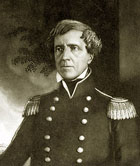Mexican American War Leaders |
Colonial Wars |
American Wars |
Link To This Page — Contact Us —
Stephen W. Kearny
? was born August 30, 1794 in Newark, New Jersey and died on October 31, 1848 in St. Louis, Missouri. He was a American Army Officer in during the War of 1812 and the Mexican American War
 |
| NAME |
| Matthew C. Perry |
| BORN |
| August 30, 1794 Newark, New Jersey |
| DIED |
| October 31, 1848 St. Louis, Missouri |
| ARMY |
| American |
Fort Kearny, Kearney City, Kearney Station, Kearney Junction, Kearney County, and the City of Kearney - all named for a man who was never stationed at the Fort. He had, however, passed through the area while leading an expedition up the Oregon Trail to South Pass in 1845. This man was General Stephen Watts Kearny, whose distinguished military service in the Mexican War led to the honor of having Fort Kearny named for him. Even earlier, Kearny's name was given to the first Fort Kearny on Table Creek near what became Nebraska City. The fort, begun in 1846, was located by Kearny who had been urging its establishment since 1838.
Stephen Watts Kearny was born in Newark, New Jersey, in 1794 into a family whose ancestors came primarily from Ireland where the name was O'Kearny. Yes, the name was spelled KEARNY, but when a postoffice was applied for at the Fort in 1849, it was misspelled KEARNEY and this misspelling has been retained since, except for the Fort, which now uses the correct Kearny name.
Kearny attended public schools and spent two years at Columbia University in New York City. Soon after he left school he joined the New York Militia and thereby established the course of his future life work. He served as a soldier for thirty-six difficult and exciting years. Because of his career choice, the plains, the mountains and the frontier West were to be his home for most of his life.
He served as a Lieutenant and Captain in the War of 1812 during which he was both injured and imprisoned briefly. Soon after that he traveled westward by boat and foot with exploration parties sent to establish new routes through the Great Plains. Fortunately, during most of his life he kept a diary which has been of great value to his future historians.
In 1819 Captain Kearny was a member of General Atkinson's Yellowstone expedition which established Cantonment Missouri (later Fort Atkinson) near present Fort Calhoun, Nebraska. This was the northernmost point reached in 1819, but Kearny was with the 1825 expedition that ended at the mouth of the Yellowstone River. During these travels he visited Indian villages, saw many buffalo and other game. Kearny admitted that he became adjusted to his wandering life with its frequent moves to new places. He studied and learned about the true course of rivers and corrected existing maps. Because the need was there, he learned to repair boats and equipment. Indian tribes accepted him well and he had satisfactory council meetings with all of them that he visited.
His government asked this capable man to supervise the building of many forts and barracks through the midwest. Major Kearny was the first commander of Jefferson Barracks in 1826, which still exists in Missouri. From there he often was invited to the city of St. Louis to visit friends. Now in his thirties he was a nice-looking, slender, tall man with soldierly bearing. While he was a guest of General Clark of Lewis and Clark fame, he met his future wife. She was Clark's stepdaughter, 18 year-old Mary Radford. Kearny won her over some competition and in 1830 married this young lady who followed him to Fort Leavenworth.
At this point in his career Kearny started a new project, that of organizing a regiment of dragoons very much like a cavalry outfit. Eighteen hundred men joined his unit and he became "the Father of the U.S. Cavalry." The unit's next headquarters were at Fort Leavenworth where Kearny was promoted to the rank of Colonel. Mary Radford Kearny accompanied her husband wherever she could. Their family now included some small children. They eventually had eleven children but all of them did not live to adulthood. Kearny was devoted to the aim of preserving peace. As commander of the army's Third Military Department, Colonel Kearny and his men were now trying to protect a thousand miles of frontier and to preserve peace among many Indian tribes. Sometimes he even ordered his soldiers to escort emigrants on the Oregon Trail across the plains so they could avoid Indian attacks.
At the outbreak of the Mexican War, Kearny was considered one of the army's most capable officers, and he was made commander of the Army of the West by President Polk and ordered to lead an expeditionary force to occupy New Mexico and California. He quickly accomplished the bloodless conquest of New Mexico on August 19, 1846, and was named military governor with headquarters in Santa Fe. Kearny was now 52 years of age.
